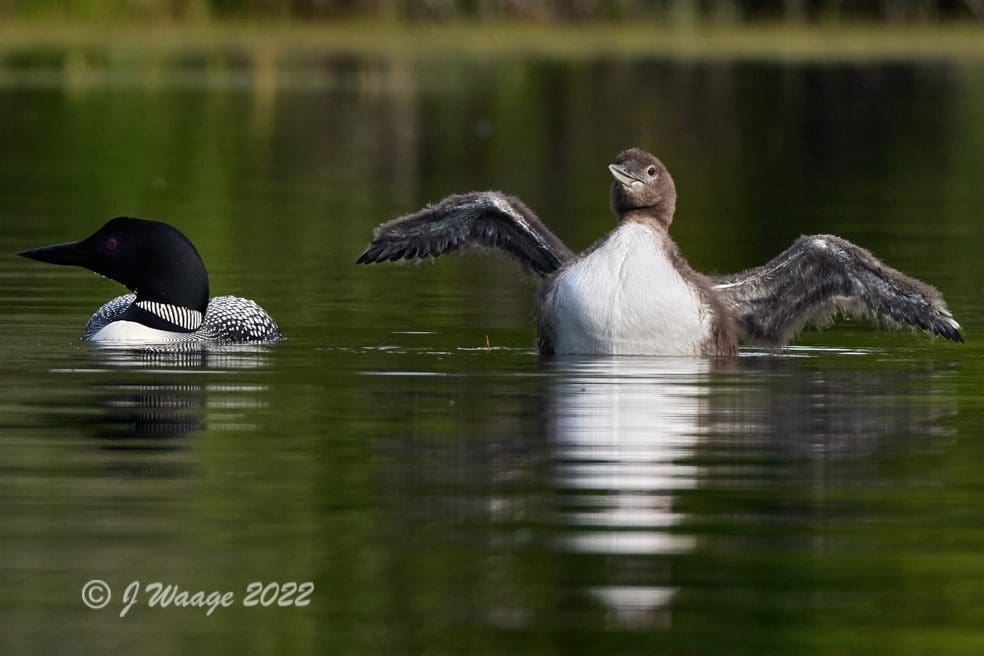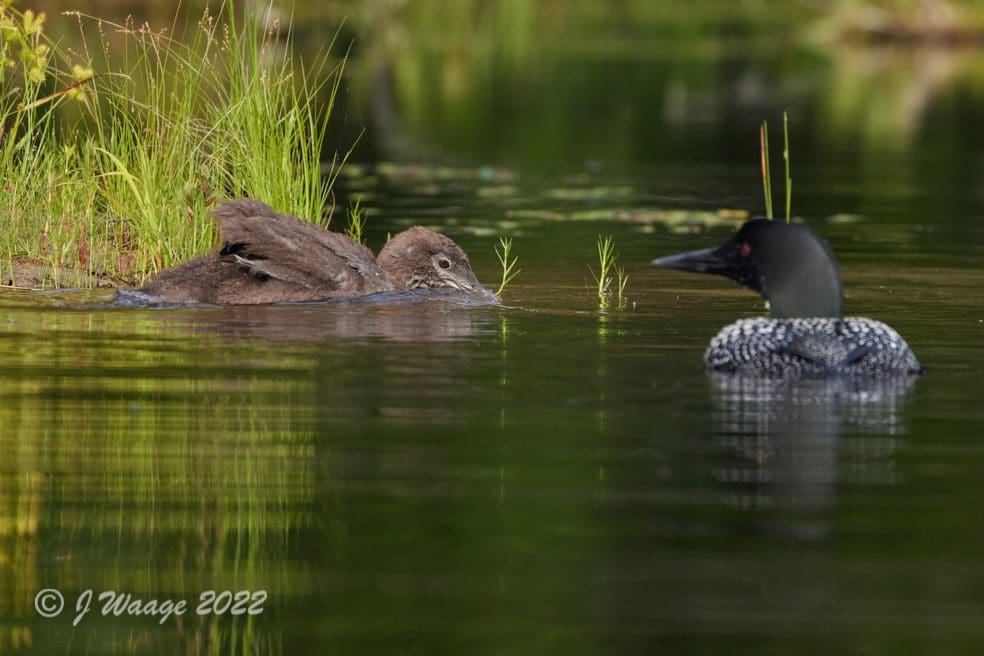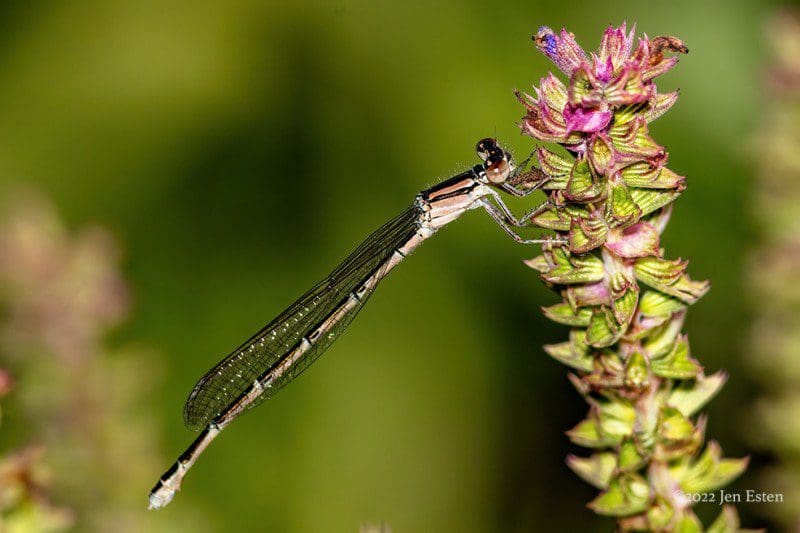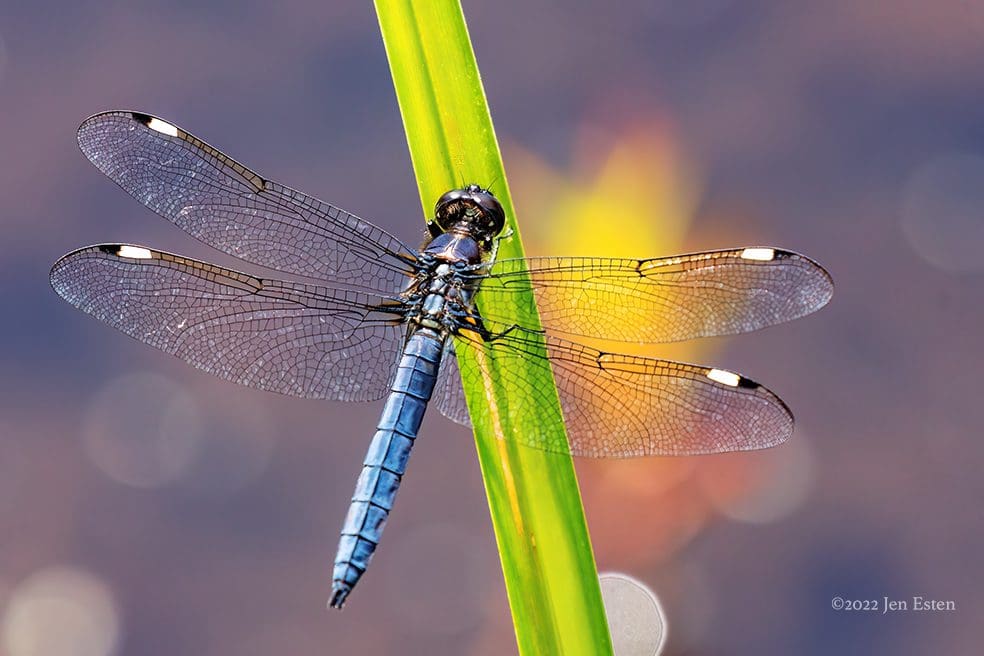Loons, Dragons and Damsels

Update on the Loons
Prosper continues to thrive and grow. I watched it hunt for things along the shore on the 18th and receive yet another Perch on the 24th. During those six days Prosper began shedding its “baby feathers” and is showing patches of juvenile Loon feathers.


What a life, with two parents bringing food and just hanging out on the lake! No wonder Prosper seems “happy”.

Other than a lot of boat activity on the Lake, things have been fairly peaceful. There is another loon (untagged as you can see below) on the Lake – usually near the Elkins end. While we drifted near each other, it was alert but not alarmed. The best way to spend time with a Loon is to just drift at a distance and watch through binoculars (or in this case a 500mm lens). That way they will stay around, fishing, preening and doing the Loony foot waggle. If you try to follow them, all they do is swim away.

As Prosper grows there is more chance it will be alone and closer to where the shallow water around the lake drops off. That puts it further out into potential boat traffic, so please keep an eye out.
Dragonflies and Damselflies
Dragonflies (Anisoptera) and Damselflies (Zygoptera) belong to an ancient lineage of insects, the Order Odonata. I would love to take a time machine back 320-325 million years to watch some of them that had two foot wing spans!
Over two hundred million years before birds flew, these insects “figured out” how to fly forwards and backwards, hover, turn on a time and control each wing independently. Some species are known to migrate seasonally as far as many birds. That includes the Common Green Darner below.

Despite being magnificent aerial predators, Odonata spend most of their life underwater as larva, catching prey with a modified lower lip. The shed larval skin below is probably a Green Darner. A folded lower jaw, nestled between its legs and eyes, has large jaws at its end. Think of covering your mouth with a hand, your elbow resting on your chest. Now shoot your hand forward, grabbing something, and bring it back to your mouth. Odonata larvae do that using hydraulic pressure at speeds faster than any muscle can contract.
Imagine being adapted to two totally different environments during your life! Talk about a midlife crisis …

The transition from larva to adult is similar to a butterfly emerging from its Chrysalis. Wings need to be expanded and dried before flying (photos below). The first flight has to be just right to get to a safe place to continue drying. You may have seen the ghostly, shimmering first flight of these insects early on a summer day.


Telling Dragonflies apart from Damselflies is pretty easy. Damselflies (below) have long slender abdomens and fold their wings completely or partially over their abdomen. One group of damselflies, the Spreadwings, leave them slightly open like the upper damselfly below.

Dragonflies rest with their wings fully open like the newly emerged Skimmer below.

Once wings harden, male Odonata generally wait at water bodies for females. Females feed inland and only go to the water to mate and lay eggs.
Female damselflies (below, probably a Bluet) tend to be less brightly colored than males.

This male Bluet is foraging away from the water. Many Damselflies will wander from the water in search of food since they mostly pick insects off of leaves rather that out of the air like Dragonflies do.

Below, a pair of Bluets are mating several yards from our pond. The mating process of Odonata is unique in the insect world. The male holds the female behind her head with special claspers and she bends her abdomen forward during mating. That results in the “heart” shape all Odonata make while mating.

No matter where they mate, damselflies come to the water where most species remain attached (“in tandem”) while the female lays her eggs in holes she pokes into aquatic vegetation. The Spreadwing pair below are laying eggs in Turtle Cove.

Most dragonfly females simply drop batches of eggs as they dip their abdomens into the water while hovering.
Many Dragonflies spend a lot of their time perching and making short flights over their territories. A colorful genus of perchers, the Pennants, have red, orange or yellow paired with black patterns in their wings. Male and female Dragonflies differ in their coloration. In the Calico Pennant, below, females are yellowish and males dark red.


Another reddish orange percher, and the second smallest dragonfly in North America, the Eastern Amberwing is common in Turtle Cove and its range extends from Canada to Florida.
Odonata have a built-in net they use to catch prey. They scoop up insects with a “net or basket” formed by their 6 spiny legs.

Shades of blue are also a common color in Dragonflies. Two skimmers (dragonflies that spend more time cruising and less perching) are the Slaty Skimmer and the Spangled Skimmer.

Notice the spots near the tips of all four wings. All damselflies and dragonflies have this special cell near the wing tip – pterostigma. They are relatively heavy cells that probably help in stabilizing the wings during gliding and flight. Their color variation helps identify some species. Slatys (above) have jet black pterostigmata and Spangleds (below) have black and white ones.

Black and white in the wings and body are common colors in skimmers that spend a lot of their time flying. The three species below are found in Turtle Cove and lots of ponds and lakes around here.
Twelve-spotted Skimmer male

Widow Skimmer male

Common Whitetail male

Odonates can be a joy to watch and binoculars will help you get a closer look. Unlike butterflies which retain much of their colors when dried and pinned in an insect collection, most dragonflies quickly loose their color. The best way to collect them is through photography, and a lens greater than 100mm will let you get a good photo from several feet away. The ultimate challenge of dragonfly photography is getting within a foot or so with your iPhone!
You may have noticed that we refer to Prosper as “it”. The tradition has been to call the first chick a male, but we can’t know Prosper’s sex unless a blood sample is taken.
Bye for now…

To be continued… Jon and Jen
Text and Photographs by Jen Esten and Jon Waage
